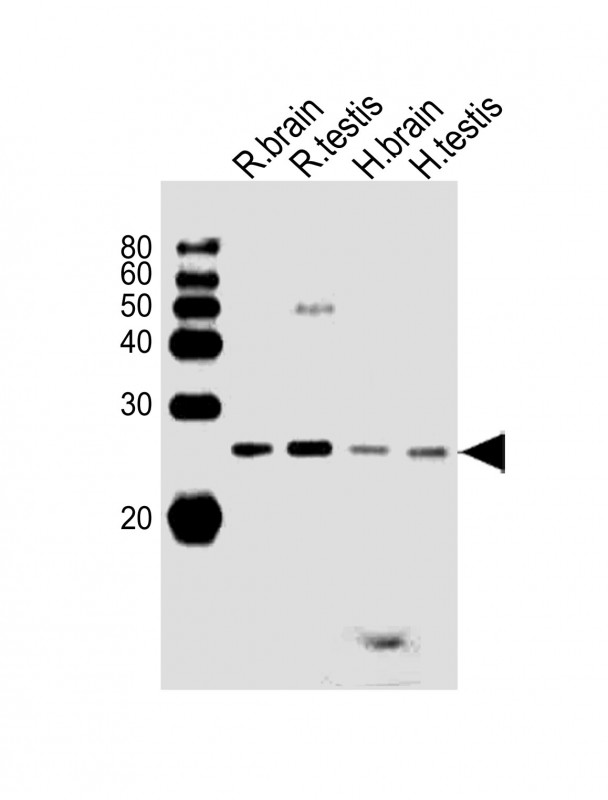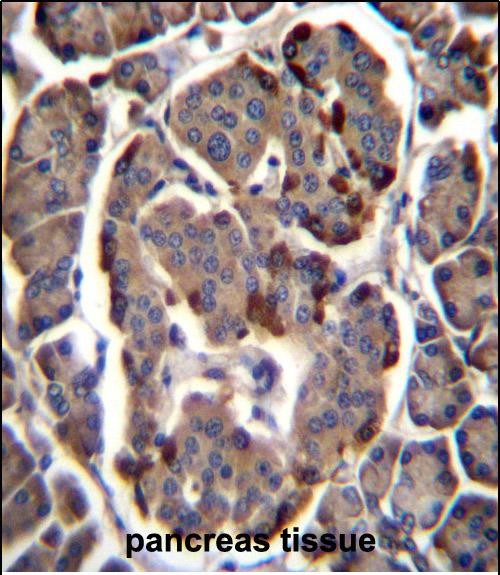RAB11B Antibody (C-term)
Affinity Purified Rabbit Polyclonal Antibody (Pab)
- 产品详情
- 文献引用 : 2
- 实验流程
- 背景知识
Application
| IHC-P, WB, E |
|---|---|
| Primary Accession | Q15907 |
| Other Accession | O35509, P46638, Q3MHP2, NP_004209.2 |
| Reactivity | Human, Rat |
| Predicted | Bovine, Mouse, Rat |
| Host | Rabbit |
| Clonality | Polyclonal |
| Isotype | Rabbit IgG |
| Calculated MW | 24489 Da |
| Antigen Region | 164-193 aa |
| Gene ID | 9230 |
|---|---|
| Other Names | Ras-related protein Rab-11B, GTP-binding protein YPT3, RAB11B, YPT3 |
| Target/Specificity | This RAB11B antibody is generated from rabbits immunized with a KLH conjugated synthetic peptide between 164-193 amino acids from the C-terminal region of human RAB11B. |
| Dilution | IHC-P~~1:100~500 WB~~1:1000 E~~Use at an assay dependent concentration. |
| Format | Purified polyclonal antibody supplied in PBS with 0.09% (W/V) sodium azide. This antibody is purified through a protein A column, followed by peptide affinity purification. |
| Storage | Maintain refrigerated at 2-8°C for up to 2 weeks. For long term storage store at -20°C in small aliquots to prevent freeze-thaw cycles. |
| Precautions | RAB11B Antibody (C-term) is for research use only and not for use in diagnostic or therapeutic procedures. |
| Name | RAB11B (HGNC:9761) |
|---|---|
| Synonyms | YPT3 |
| Function | The small GTPases Rab are key regulators of intracellular membrane trafficking, from the formation of transport vesicles to their fusion with membranes. Rabs cycle between an inactive GDP-bound form and an active GTP-bound form that is able to recruit to membranes different set of downstream effectors directly responsible for vesicle formation, movement, tethering and fusion (PubMed:14627637, PubMed:19029296, PubMed:19244346, PubMed:20717956, PubMed:21248079, PubMed:22129970, PubMed:26032412). The small Rab GTPase RAB11B plays a role in endocytic recycling, regulating apical recycling of several transmembrane proteins including cystic fibrosis transmembrane conductance regulator/CFTR, epithelial sodium channel/ENaC, potassium voltage-gated channel, and voltage-dependent L-type calcium channel. May also regulate constitutive and regulated secretion, like insulin granule exocytosis. Required for melanosome transport and release from melanocytes. Also regulates V-ATPase intracellular transport in response to extracellular acidosis (PubMed:14627637, PubMed:19029296, PubMed:19244346, PubMed:20717956, PubMed:21248079, PubMed:22129970). Promotes Rabin8/RAB3IP preciliary vesicular trafficking to mother centriole by forming a ciliary targeting complex containing Rab11, ASAP1, Rabin8/RAB3IP, RAB11FIP3 and ARF4, thereby regulating ciliogenesis initiation (PubMed:25673879). On the contrary, upon LPAR1 receptor signaling pathway activation, interaction with phosphorylated WDR44 prevents Rab11-RAB3IP-RAB11FIP3 complex formation and cilia growth (PubMed:31204173). |
| Cellular Location | Recycling endosome membrane {ECO:0000250|UniProtKB:P46638}; Lipid-anchor {ECO:0000250|UniProtKB:P46638}; Cytoplasmic side {ECO:0000250|UniProtKB:P46638}. Cytoplasmic vesicle, secretory vesicle, synaptic vesicle membrane {ECO:0000250|UniProtKB:O35509}; Lipid-anchor {ECO:0000250|UniProtKB:O35509}; Cytoplasmic side {ECO:0000250|UniProtKB:O35509}. Cytoplasmic vesicle, phagosome membrane; Lipid-anchor; Cytoplasmic side. Cytoplasmic vesicle. Note=Recruited to phagosomes containing S.aureus. Colocalizes with RAB11AFIP1 on punctate vesicles (PubMed:26032412). |
For Research Use Only. Not For Use In Diagnostic Procedures.

Provided below are standard protocols that you may find useful for product applications.
BACKGROUND
The Ras superfamily of small GTP-binding proteins, which includes the Ras (see MIM 190020), Ral (see MIM 179550), Rho (see MIM 165390), Rap (see MIM 179520), and Rab (see MIM 179508) families, is involved in controlling a diverse set of essential cellular functions. The Rab family, including RAB11B, appears to play a critical role in regulating exocytotic and endocytotic pathways (summary by Zhu et al., 1994 [PubMed 7811277]).[supplied by OMIM].
REFERENCES
Agop-Nersesian, C., et al. PLoS Pathog. 6 (7), E1001029 (2010) :
Silvis, M.R., et al. Mol. Biol. Cell 20(8):2337-2350(2009)
Kathiresan, S., et al. Nat. Genet. 41(1):56-65(2009)
Scapin, S.M., et al. J. Struct. Biol. 154(3):260-268(2006)
Khvotchev, M.V., et al. J. Neurosci. 23(33):10531-10539(2003)
终于等到您。ABCEPTA(百远生物)抗体产品。
点击下方“我要评价 ”按钮提交您的反馈信息,您的反馈和评价是我们最宝贵的财富之一,
我们将在1-3个工作日内处理您的反馈信息。
如有疑问,联系:0512-88856768 tech-china@abcepta.com.






















 癌症的基本特征包括细胞增殖、血管生成、迁移、凋亡逃避机制和细胞永生等。找到癌症发生过程中这些通路的关键标记物和对应的抗体用于检测至关重要。
癌症的基本特征包括细胞增殖、血管生成、迁移、凋亡逃避机制和细胞永生等。找到癌症发生过程中这些通路的关键标记物和对应的抗体用于检测至关重要。 为您推荐一个泛素化位点预测神器——泛素化分析工具,可以为您的蛋白的泛素化位点作出预测和评分。
为您推荐一个泛素化位点预测神器——泛素化分析工具,可以为您的蛋白的泛素化位点作出预测和评分。 细胞自噬受体图形绘图工具为你的蛋白的细胞受体结合位点作出预测和评分,识别结合到自噬通路中的蛋白是非常重要的,便于让我们理解自噬在正常生理、病理过程中的作用,如发育、细胞分化、神经退化性疾病、压力条件下、感染和癌症。
细胞自噬受体图形绘图工具为你的蛋白的细胞受体结合位点作出预测和评分,识别结合到自噬通路中的蛋白是非常重要的,便于让我们理解自噬在正常生理、病理过程中的作用,如发育、细胞分化、神经退化性疾病、压力条件下、感染和癌症。







